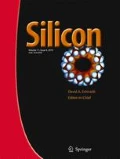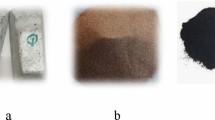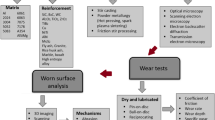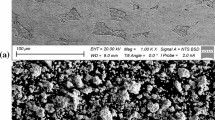Abstract
Cu-11Ni-4Si/10wt.% Si3N4 functionally graded composite of dimension Øout 100 mm × Øin 70 mm × 100 mm was fabricated via centrifugal casting and the mechanical and three body abrasive wear behavior were studied. Microstructural analysis along the radial direction revealed high concentration of Si3N4 particles at the inner periphery of the composite, and XRD analysis confirmed the presence of introduced reinforcement. Highest micro-hardness (207 HV) was observed at the inner periphery of composite having highest concentration (53 vol.%) of reinforcement particles and the inner zone displayed higher tensile strength (425.58 MPa). Abrasive wear test based on L27 orthogonal array, was performed only at inner periphery based on the mechanical behavior. Signal-to-Noise ratio and Analysis of Variance were performed to analyze the influence of parameters such as load, speed and time on wear rate. Results showed that applied load had the highest influence (60.45%) on wear rate followed by speed and time. Scanning electron microscopy analysis was carried out on worn samples and was observed that wear changed from mild to severe as parameters were increased. This composite is suited for automotive applications where the improved abrasive wear characteristics can be utilized to a greater effect.
Similar content being viewed by others
References
Rajan T P D, Pai B C (2014) Developments in processing of functionally gradient metals and metal-ceramic composites: a review. Acta Metall Sin English Lett 27:825. https://doi.org/10.1007/s40195-014-0142-3
Yan-Boliu Z, Ming C, Kai W, Mao-Hua Z, Yong X (2010) Characteristics of two Al based functionally gradient composites reinforced by primary Si particles and Si/in situ Mg2Si particles in centrifugal casting. Trans Nonferrous Met Soc China 20:361–370. https://doi.org/10.1016/S1003-6326(09)60147-3
Alidokht S A, Abdollah-zadeh A, Soleymani S, Saeid T, Assadi H (2012) Evaluation of microstructure and wear behavior of friction stir processed cast aluminum alloy. Mater Char 63:90–97. https://doi.org/10.1016/j.matchar.2011.11.007
Rana R S, Purohit R, Das S (2012) Reviews on the influences of alloying elements on the microstructure and mechanical properties of aluminum alloys and aluminum alloy composites. Int J Sci Res Pub 2(6):90–97
Gao J W, Wan C Y (2000) Modeling the solidification of functionally graded materials by centrifugal casting. Mater Sci Eng 292:207–215. https://doi.org/10.1016/S0921-5093(00)01014-5
Mahmood R M, Member E T A, Shukla M, Pityana S (2012) Functionally graded material: an overview. World Congr Eng III:2–6. https://doi.org/10.1016/j.mspro.2014.07.442
Hari Babu U, Vijay Sai N (2015) Evaluating the mechanical properties of copper red mud composites. Int J Eng Development Res 3:20–24
Kumari S, Kumar A, Sengupta P R, et al. (2014) Improving the mechanical and thermal properties of semi-coke based carbon/copper composites reinforced using carbon nanotubes. Adv Mater Lett 5:265–271. https://doi.org/10.5185/amlett.2013.10546
Mallik S, Ekere N, Best C, Bhatti R (2011) Investigation of thermal management materials for automotive electronic control units. Appl Therm Eng 31:355–362. https://doi.org/10.1016/j.applthermaleng.2010.09.023
Shabani M, Paydar M. H., Zamiri R, et al. (2016) Microstructural and sliding wear behavior of SiC-particle reinforced copper matrix composites fabricated by sintering and sinter-forging processes. J Mater Res Technol 5:5–12. https://doi.org/10.1016/j.jmrt.2015.03.002
Deshpande P K, Lin R Y (2006) Wear resistance of WC particle reinforced copper matrix composites and the effect of porosity. Mater Sci Eng A 418:137–145. https://doi.org/10.1016/j.msea.2005.11.036
Juszczyk B, Kulasa J, Malec W, et al. (2014) Microstructure and tribological properties of the copper matrix composite materials containing lubricating phase particles. Arch Metall Mater 59:365–369. https://doi.org/10.2478/amm-2014-0061
Kumar J, Mondal S (2018) Microstructure and properties of graphite-reinforced copper matrix composites. J Braz Soc Mech Sci Eng. https://doi.org/10.1007/s40430-018-1115-7
Li J F, Zhang L, Xiao J K, Zhou K C (2015) Sliding wear behavior of copper-based composites reinforced with graphene nanosheets and graphite. Trans Nonferrous Met Soc China English Ed 25:3354–3362. https://doi.org/10.1016/S1003-6326(15)63970-X
Bertolino N, Monagheddu M, Tacca A, et al. (2003) Self-propagating high-temperature synthesis of functionally graded materials as thermal protection systems for high-temperature applications. J Mater Res 18:448–455. https://doi.org/10.1557/JMR.2003.0057
Tejas U, Amarjit S, Reddy Y, Khatitrkar R K, Sapate S G (2013) Abrasive wear behavior of copper-SiC and copper-SiO2 composites. Int J Modern Phys Conf Ser 22:416–423. https://doi.org/10.1142/S2010194513010465
Shehata F, Fathy A, Abdelhameed M, Moustafa S F (2009) Preparation and properties of Al2O3 nanoparticle reinforced copper matrix composites by in situ processing. Mater Des 30:2756–2762. https://doi.org/10.1016/j.matdes.2008.10.005
Ul Haq MI, Anand A (2018) Dry Sliding friction and wear behavior of AA7075-Si3 N 4 composite. Silicon. https://doi.org/10.1007/s12633-017-9675-1
Sabine A M (1992) Thermodynamic re-evaluation of the Cu-Ni system. Calphad 16 (3):255–260. https://doi.org/10.1016/0364-5916(92)90022-P
Varin R A, Song Y K (2001) Effects of environment on fracture toughness of binary and ternary nickel silicide-based intermetallics. Intermetallics 9(8):647–660. https://doi.org/10.1016/S0966-9795(01)00050-4
Theivasanthi T, Alagar M (2010) X-ray diffraction studies of copper nanopowder. arXiv:1003.6068
Bai Y J, Bian J, Wang C G, Zhu B, Qi Y X, Wang Y X, Liu Y X, Geng G L (2005) One step convenient synthesis of crystalline β-Si3N4. J Mater Chem 15(45):4832–4837
Xie H, Jia L, Lu Z (2009) Microstructure and solidification behavior of Cu–Ni–Si alloys. Mater Chara 60(2):114–118. https://doi.org/10.1016/j.matchar.2008.07.008
Lei Q, Xiao Z, Hu W, Derby B, Li Z (2017) Phase transformation behaviors and properties of a high strength Cu-Ni-Si alloy. Mater Sci Eng A 697:37–47. https://doi.org/10.1016/j.msea.2017.05.001
Myriounis D P, Hasan S T, Matikas T E (2008) Microdeformation behaviour of Al–SiC metal matrix composites. Comp Interf 15:495–514. https://doi.org/10.1163/156855408784655292
Nithesh R, Radhika N, Sunder S S (2017) Mechanical properties and adhesive scuffing wear behavior of stir cast Cu–Sn–Ni/Si3N4 composites. J Tribol 139(6):061603. https://doi.org/10.1115/1.4036185
Yigezu B S, Mahapatra M M, Jha P K (2013) Influence of reinforcement type on microstructure, hardness, and tensile properties of an aluminum alloy metal matrix composite. J Miner Mater Char Eng 1:124–31. https://doi.org/10.4236/jmmce.2013.14022
Cheng S L, Yang G C, Zhu M, Wang J C, Zhou H H (2010) Mechanical properties and fracture mechanisms of aluminum matrix composites reinforced by Al9(Co,Ni)2 Intermetallics. Trans Nonferrous Met Soc China 20:572–76. https://doi.org/10.1016/S1003-6326(09)60180-1
Radhika N, Raghu R (2016) Development of functionally graded aluminium composites using centrifugal casting and influence of reinforcements on mechanical and wear properties. Trans Nonferrous Met Soc China 26:905–916. https://doi.org/10.1016/S1003-6326(16)64185-7
Mondal D P, Das S (2006) High stress abrasive wear behavior of aluminium hard particle composites: effect of experimental parameters, particle size and volume fraction. Tribol Inter 39 (6):470–478. https://doi.org/10.1016/j.triboint.2005.03.003
Radhika N (2017) Mechanical properties and abrasive wear behaviour of functionally graded Al-Si12Cu/Al2O3 metal matrix composite. T Ind I Metals 70:145–157. https://doi.org/10.1007/s12666-016-0870-3
Radhika N, Raghu R (2016) Abrasive wear behavior of monolithic alloy, homogeneous and functionally graded aluminum (LM25/aln and LM25/sio2) composites. Particul Sci Technol 1:1–11. https://doi.org/10.1080/02726351.2016.1199074
Author information
Authors and Affiliations
Corresponding author
Rights and permissions
About this article
Cite this article
Radhika, N., Jefferson, J.A. Studies on Mechanical and Abrasive Wear Properties of Cu-Ni-Si/Si3N4 Functionally Graded Composite. Silicon 11, 627–641 (2019). https://doi.org/10.1007/s12633-018-9957-2
Received:
Accepted:
Published:
Issue Date:
DOI: https://doi.org/10.1007/s12633-018-9957-2




